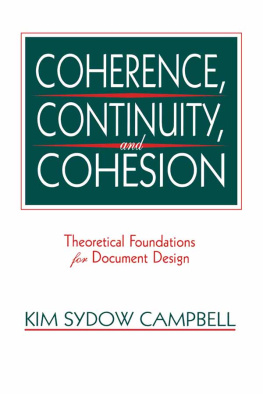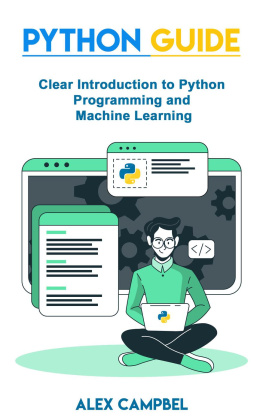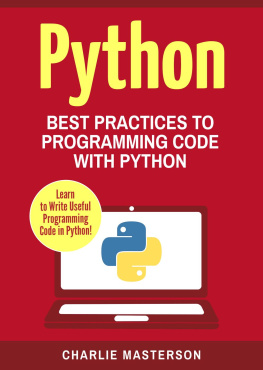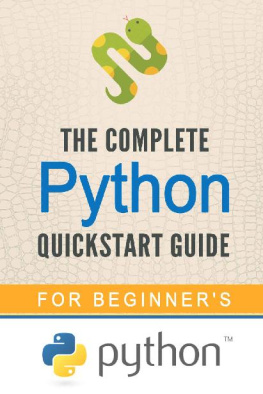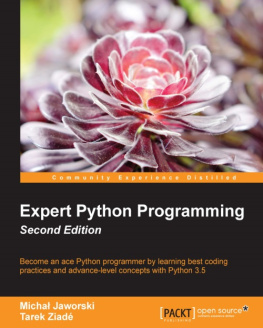Campbell - PYTHON PROGRAMMING: The ultimate guide from a beginner to expert, all you need to know about python, tools, tricks, best practices, and advanced features
Here you can read online Campbell - PYTHON PROGRAMMING: The ultimate guide from a beginner to expert, all you need to know about python, tools, tricks, best practices, and advanced features full text of the book (entire story) in english for free. Download pdf and epub, get meaning, cover and reviews about this ebook. year: 2019, genre: Computer. Description of the work, (preface) as well as reviews are available. Best literature library LitArk.com created for fans of good reading and offers a wide selection of genres:
Romance novel
Science fiction
Adventure
Detective
Science
History
Home and family
Prose
Art
Politics
Computer
Non-fiction
Religion
Business
Children
Humor
Choose a favorite category and find really read worthwhile books. Enjoy immersion in the world of imagination, feel the emotions of the characters or learn something new for yourself, make an fascinating discovery.

PYTHON PROGRAMMING: The ultimate guide from a beginner to expert, all you need to know about python, tools, tricks, best practices, and advanced features: summary, description and annotation
We offer to read an annotation, description, summary or preface (depends on what the author of the book "PYTHON PROGRAMMING: The ultimate guide from a beginner to expert, all you need to know about python, tools, tricks, best practices, and advanced features" wrote himself). If you haven't found the necessary information about the book — write in the comments, we will try to find it.
Campbell: author's other books
Who wrote PYTHON PROGRAMMING: The ultimate guide from a beginner to expert, all you need to know about python, tools, tricks, best practices, and advanced features? Find out the surname, the name of the author of the book and a list of all author's works by series.
PYTHON PROGRAMMING: The ultimate guide from a beginner to expert, all you need to know about python, tools, tricks, best practices, and advanced features — read online for free the complete book (whole text) full work
Below is the text of the book, divided by pages. System saving the place of the last page read, allows you to conveniently read the book "PYTHON PROGRAMMING: The ultimate guide from a beginner to expert, all you need to know about python, tools, tricks, best practices, and advanced features" online for free, without having to search again every time where you left off. Put a bookmark, and you can go to the page where you finished reading at any time.
Font size:
Interval:
Bookmark:

- Basics of Python Programming Language
- Types of Variables
- Methods/Functions in Python
- Flow Control in Python
- Data Processing, Analysis, and Visualization
- Applications of Machine Learning
- Inheritance and Polymorphism
- Special Functions/Methods
- Exception Handling
- Visit Download Python page which is the credible site and click Download Python 3.7.2 (The version may differ from the one stated here).
- When the download completes, click open the package and follow the instructions given. The installation should complete with The installation was successful prompt.
- Now, visit Download Notepad++ and download the text editor and install it by opening the package and following the message prompts. The Notepad++ text editor is free and suited to help write source code (raw text programming words).
- On Debian derivatives such as Ubuntu, use apt .
- On Red Hat and derivatives, use yum .
- On SUSE and derivatives, use zypper .
- Visit Download Python site which is the recommended site and click Download Python 3.7.2 (The version may differ from the one stated here).
- When your download completes, open the package by clicking and follow the guidelines given. The Python installation should complete with The installation was successful prompt.
- Now, visit Download Notepad++ and download the text editor and install it by opening the package and following the message prompts. The Notepad++ text editor is free and suited to help write source code (raw text programming words).
Font size:
Interval:
Bookmark:
Similar books «PYTHON PROGRAMMING: The ultimate guide from a beginner to expert, all you need to know about python, tools, tricks, best practices, and advanced features»
Look at similar books to PYTHON PROGRAMMING: The ultimate guide from a beginner to expert, all you need to know about python, tools, tricks, best practices, and advanced features. We have selected literature similar in name and meaning in the hope of providing readers with more options to find new, interesting, not yet read works.
Discussion, reviews of the book PYTHON PROGRAMMING: The ultimate guide from a beginner to expert, all you need to know about python, tools, tricks, best practices, and advanced features and just readers' own opinions. Leave your comments, write what you think about the work, its meaning or the main characters. Specify what exactly you liked and what you didn't like, and why you think so.

